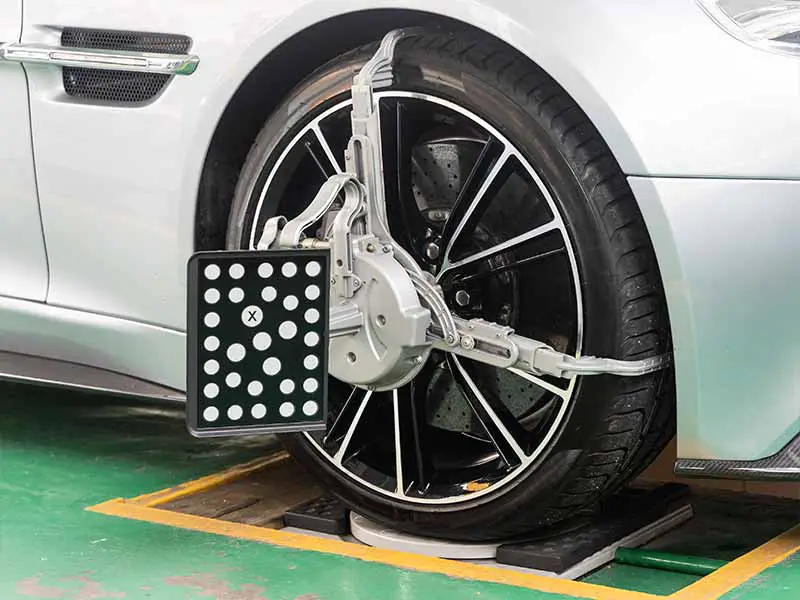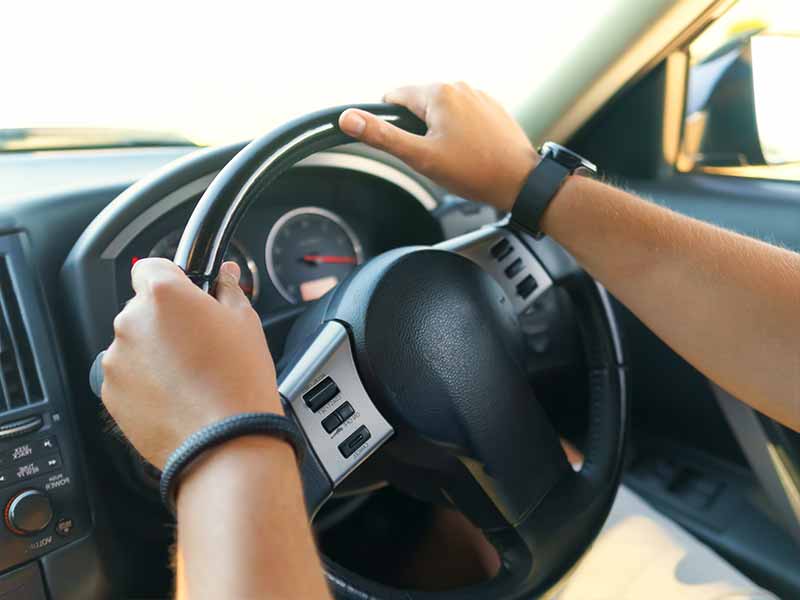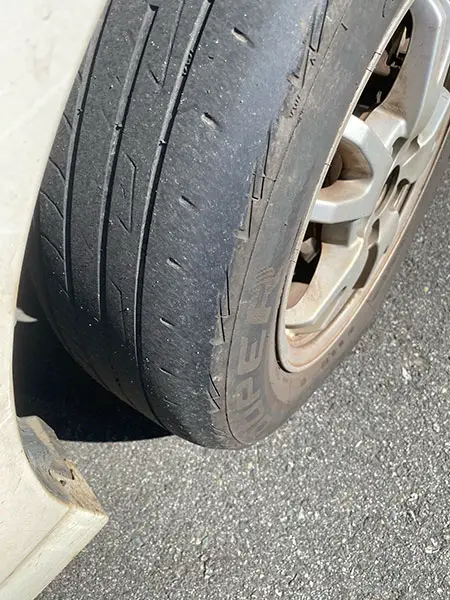If you’re like most people, you probably don’t think much about getting your wheels aligned. But the truth is, having proper wheel alignment is important to prevent uneven wear and ensure your car or truck tracks straight and true down the road.

How Often Should You Get An Alignment?
Most drivers should have an alignment performed every 10,000 miles, which coincides with how often you should get your tires rotated. This frequency ensures your tires wear evenly and handling performance is optimal.
This interval will also help you save money by reducing trips to your local tire shop.
If you mostly drive on smooth roads, do a lot of highway driving, or don’t put a lot of stress on your wheels and tires, you may be able to go longer between alignments.
Let’s take a closer look.

After How Many Miles Should You Get An Alignment?
As a general rule of thumb, we recommend getting a wheel alignment every 10,000 miles. But, if you do a lot of highway driving, you may be able to go longer between alignments. On the other hand, if you do a lot of city driving or if you frequently hit potholes or curbs, you may need to get an alignment more often.
We recommend most people have an alignment performed every 10,000 miles to combine multiple tire maintenance services into one visit. Combining tire rotations and wheel alignment into a single trip to your local tire shop kills two birds with one stone.
It’s also a good idea to get an alignment whenever you have new tires installed or after hitting a significant pothole or curb. Regular alignments can help extend your tires’ life and improve your vehicle’s overall handling and performance.
Don’t wait until you start experiencing symptoms like uneven tire wear or a pulling vehicle – regular alignments can help prevent these problems from occurring in the first place.
What Are The Signs Of A Bad Alignment?
Here are a few common symptoms of an incorrect wheel alignment that you should look out for:

Uneven Tire Wear
When your wheels are properly aligned, they all make equal contact with the road and wear down evenly. But when they’re out of alignment, they put extra stress on certain tires and unevenly across each tire’s tread, causing them to wear down faster. This not only means you’ll need to replace your tires sooner, but it can also negatively impact your car’s handling and stability.

Pulling To One Side
A correct wheel alignment allows all four tires to work together to keep your car moving straight down the road. But when they’re out of alignment, one wheel may be angled differently from the others, causing your car or truck to pull in that direction.
Steering Wheel Vibration
Incorrect alignment causes your tires to against each other, which can create steering wheel vibrations. But when they’re in alignment, your tires can make even contact with the road and gives you a smooth ride with predictable handling.

Steering Wheel Off Center
If your wheels are out of alignment, you may have to adjust to keep the vehicle driving straight constantly. This not only makes for an unpleasant driving experience but can also cause additional wear and tear on your tires, suspension, and steering components.

Strange Handling
“Strange handling” can mean many different things, but if it’s related to poor wheel alignment, it could mean a few different symptoms. Here are some common ways that poor alignment can affect your car’s handling:
- The steering wheel feels loose or “wobbly” when driving straight.
- The vehicle pulls to one side or the other when you’re driving straight.
- The car feels like it’s drifting or wandering around the road, even when you’re trying to drive in a straight line.
- When you turn the steering wheel, the car feels “sluggish” or unresponsive.
All of these symptoms can be signs of poor alignment, and they can make driving a lot less fun and a lot more stressful.
Is It OK To Drive A Car That Is Out Of Alignment?
Driving a car that’s out of alignment can be frustrating and cause long-term damage to your tires, suspension, and steering components.

When your car is out of alignment, it means that the wheels are not properly aligned with each other, which can cause problems with handling, stability, and even your tires. While you can technically drive an out-of-alignment car, it is not recommended.
If left unaddressed, an out-of-alignment car can lead to increased wear and tear on your tires, poor gas mileage, and even potential safety hazards while driving.
What Throws A Car Out Of Alignment?
There are a few things that can throw your car out of alignment. Potholes, curb strikes, and even just driving over rough roads can cause your wheels to get knocked out of alignment. If you’ve been involved in a car accident, even a minor one, it’s a good idea to check your alignment because the impact can easily cause your wheels to become misaligned.

Another factor that can cause your car to become out of alignment is worn suspension and steering components. As these parts wear, they can cause your wheels to become misaligned. If you notice that your car is pulling to one side or if your steering wheel is no longer centered, these could be signs that your suspension and steering components need to be replaced.
What Does A Wheel Alignment Do?
A wheel alignment is a process that adjusts the angles of your wheels to ensure that they are correctly aligned with the road. This is an important service for maintaining the safety and handling of your vehicle, as well as for prolonging the lifespan of your tires.
During a wheel alignment, a technician will measure the angles of your wheels and make any necessary adjustments to bring them into proper alignment. This can include adjusting the camber, caster, and toe angles of your wheels, which are critical for ensuring that your vehicle handles correctly and that your tires wear evenly.
A 4-wheel alignment adjusts the angle of all four wheels, ensuring they all point in the same direction and work together. You’ll most likely need this type of alignment since most modern cars and trucks need all four wheels aligned.
A 2-wheel alignment, on the other hand, only adjusts the angle of the front two wheels. This type of alignment is typically only performed on cars and trucks with a solid rear axle that doesn’t allow for wheel alignment adjustments.
Resources
Below are some links you may find helpful when learning about tires
- How often should you get your alignment checked per year – Les Schwab
- Tire alignment: What you need to know – Bridgestone
Final Thoughts
When it comes to your car or truck, wheel alignment is an important aspect of maintenance. How frequently you need this service performed depends on a few factors, such as driving conditions, the type of roads you regularly drive on, and how you drive your vehicle.
If you drive mainly on smooth roads, you might only need to get an alignment once every two years or so. If you drive on rough roads or frequently hit potholes or curbs, you may need to get an alignment more frequently. Also, if you drive aggressively, such as taking sharp turns or making sudden stops, your vehicle might need an alignment more often as well.
We recommend a wheel alignment every 10,000 miles to save you trips to the tire alignment shop. You can have tire alignment and rotation performed at the same time. If you don’t need wheel alignment as often, you may be able to push it out to 20,000 miles to continue combining tire maintenance services.
If you suspect your vehicle might be out of alignment, it’s best to have it inspected by a professional mechanic. It’s always a good idea to have your alignment checked when you get new tires, as well as during regular vehicle maintenance. You can also check for signs of poor alignment, such as uneven tire wear or an off-center steering wheel.
Good luck and happy motoring.




